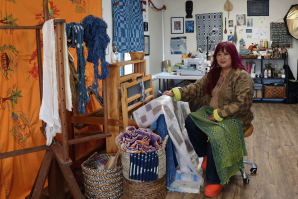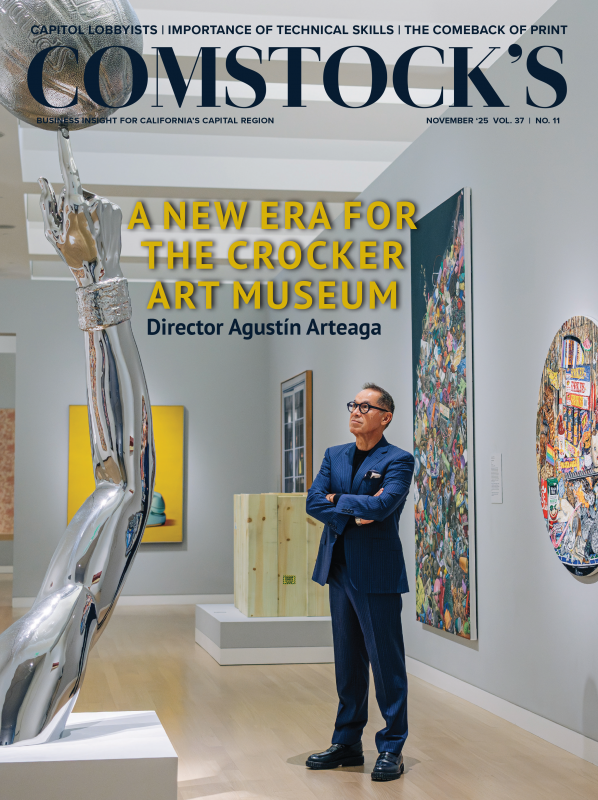Even if Agustín Arteaga, the new Mort and Marcy Friedman director and chief executive officer of the Crocker Art Museum, were to exhibit only the pastry paintings of the late Wayne Thiebaud, the job would hardly be a cakewalk.
As he learned in his eight years at the Dallas Museum of Art — as well as previous stints as director of the Museo Nacional de Arte in Mexico City and the Museo de Arte de Ponce in Puerto Rico — Arteaga also needs to be a master juggler. His job requires him to maintain the viability and contemporary relevance of the oldest art museum in the West.
Fundraising is also a constant challenge — as are customer relations, marketing, educational programs that cultivate the next generations of museum goers, artists and art collectors. Arteaga needs to stay in constant and friendly touch with the museum’s reliable donors of artworks, as well as to build a new base of contributors. Underlying all of this is the political reality of maintaining transparency with elected officials that provide the Crocker with some of its funding.
If all of that sounds like herding cats — sophisticated ones, at that, but each with a variety of wish lists — then Arteaga may have found the ideal job fit.
“In the first two months I was here, I had at least 70 meetings with everyone from the board, the administrative staff, the docents, the people who handle security and the janitors,” he says late one morning last month at Blueprint Coffee Project in Old Sacramento. It’s situated at the historic area’s Tower Bridge border, and Arteaga has walked to this interview from his offices at the Crocker just across the Sacramento River.
Arteaga was born in Mexico City, and his accent remains. Not only is his English impeccably articulate, but he also speaks a few other languages, including French, Portuguese and, as he says, “a little bit of Italian.”
Dressed this morning in a pale blue sweater under a pinstripe suit, Arteaga is slender and compact. He loves to smile. “I shaved this morning just for you,” he half jokes. He really did, but clarifies it was just the kind of scruff men walk around in for a few days.
Arteaga was hired after a nationwide hunt for a successor to Lial Jones, who decided to retire after more than two highly productive decades in the post — years that saw the museum undergo a multi-million-dollar upgrade and expansion. Arteaga praises Jones’ work, has serious compliments for longtime museum curator Scott Shields and “tremendous respect” for artist and philanthropist Marcy Friedman, who, with her late husband Mort, created and finances Arteaga’s post.
Asked about his vision for the Crocker, he says, “I want to continue my listening tour and find out how people feel about this place before I finalize any kind of plan. I think the Crocker’s an absolute treasure. And sometimes when people I’ve met here say they’ve been to the Louvre in Paris or El Prado in Spain or the MOMA in New York, I ask them, ‘But have you been to your own magnificent local art museum?’”
He has a point. Even though the Crocker appears to be popular “among people from all walks of life,” it has long had an undeserved reputation as being a place that has only “old” art. Yet despite its preponderance of classical paintings dating back centuries, some of its paintings that are only 100-150 years old actually comprised contemporary art in their own time — meaning that an 1800s painting was new when it was acquired by Judge Edwin Bryant Crocker and his wife Margaret Rhodes Crocker during their continental and California buying sprees a century-and-a-half ago.
In more recent years, the museum has obtained the works of the aforementioned Thiebaud and scores of still living and producing artists whom contemporary visitors would find very much up to date. That dual identity seems like a pretty good pace to start our chat.
The Crocker Art Museum is the oldest museum in the West. The
Crocker family donated its Victorian art-filled home to the city
in 1885. The current museum has an abundant collection of
world-class classic and contemporary art.

COMSTOCK’S: You walked here this morning and said you really enjoy walking through Sacramento.
ARTEAGA: Yes, yes. I find this city fascinating for a number of reasons. I love the architecture of the Crocker Museum building, the Stanford Home and the whole arts-and-crafts designs that run throughout the homes in Midtown. It’s nice to be in a city where you can look at its buildings and get a sense of how it all came to be, how people lived in another era. I trained as an architect but never worked as one. But the training really helped in my career in art conservation. Sometimes, it takes an architect’s eye to bring something back to its initial splendor. I’ve overseen a number of restorations and remodels of museums, here, in Mexico and Buenos Aires.
COMSTOCK’S: When you sat down, you mentioned that there was something on your walk here that bothered you.
ARTEAGA: Well, not so much bothered me but something I felt could use improvement. As I walked across the bridge, I saw banners for music festivals and concerts but nothing that celebrated culture or the arts in Sacramento. This is a major city but people who live here don’t always treat it like one, though they clearly love it. The world has been waking up to Sacramento being an employment and sports and recreational hub, which is great, but we also have a sophisticated and surprisingly accessible arts scene here. But we also have the prestige and history.
COMSTOCK’S: You have a Ph.D. in art history and told me earlier that one of your visions for the Crocker is an in-house art conservation lab.
ARTEAGA: Right. It bothered me to see that the Crocker’s conservation department, or what’s left of it, is used for storage. So if a piece needs to be restored or looked after, we have to hire people from outside the city, sometimes from very far away. One of my fundraising goals is to fully staff an onsite lab for restoration, preservation and conservation. We’ll save a great deal of money and time — and maybe even retain more control over our collections.
COMSTOCK’S: Because the museum has always encouraged visitors to become members of the Crocker Art Museum Association, or CAMA, do you think the place sounds more like a private club one joins rather than a public museum one can simply take in when the right show comes along?
Crocker Art Museum Director Agustín Arteaga on the balcony of the
Teel Family Pavilion — the modern wing of the Crocker Art Museum.

COMSTOCK’S: You’ve inherited quite a team with your job, among them Scott Shields, who’s been the museum’s curator for a couple of decades.
ARTEAGA: Yes, Scott’s amazing. In addition to knowing art, he knows this building, this facility, better than anyone — meaning he knows what’s possible for us to show here and how to show it. He’s also an excellent storyteller and the narratives he writes from scratch or adapts for each show add a great deal to how they’re shown here, and accepted. I think most of us who work here are educators at heart.
COMSTOCK’S: Explain that a little.
ARTEAGA: The best teachers know their subject matter but also love their subject matter. I think almost all of us, from the security people to the docents and other volunteers, from the front desk people to everyone behind the scenes, have a passion for art — and even for this very building, which it would be difficult to not love.
COMSTOCK’S: Before we started the dialogue part of this chat, you mentioned that you thought of the Crocker as a gateway.
ARTEAGA: Yes, absolutely. And I want people throughout the city and region and state and even the entire country to see the Crocker Art Museum as a gateway into the the capital of a state with the largest economy in the United States — and if California were a country, the fourth-largest economy in the entire world — Sacramento is deserving of attention and respect. We’re also incredibly diverse, culturally.
COMSTOCK’S: A 2002 Harvard study said Sacramento was the most diverse city in the country, and we’re still right up there. In your previous jobs, you brought in shows that emphasized diversity, as we previously discussed. If you could summarize your vision, it seems that diversity and inclusion would be high on your list.
ARTEAGA (Laughs): Yes, I think my vision for the Crocker may be a bit obvious when it comes to that. This place has to represent the past, present and future, all of the people who’ve made it what it is and all the people who’ll continue to grow Sacramento. Sometimes this might happen in a single show but sometimes all at once. Art says so much about an area’s culture — no, make that an area’s cultures, with an s.
COMSTOCK’S: You have a reputation for embracing diversity. As you told this magazine in an interview earlier this year, you saw that almost 40 percent of the population in Dallas, where you previously worked, was from Mexico and Latin America but that “there was no Spanish signage or text on the walls” — and that you said, “Well, if we really want to have that community coming over, we probably should be more mindful about how we can host them and welcome them.” What are some of the shows we can expect to see that amplifies this inclusive sensibility of yours?
ARTEAGA: Two things come immediately to mind. When this article appears in November, we’ll be presenting “Making Moves,” a feminist art show featuring two very prized self portraits by Frida Kahlo. And starting January 31, we’ll be opening a show called “The Sense of Beauty,” featuring works by Rubens, Goya, El Greco and Lord Frederick Leighton’s famous “Flaming June,” along with 40 Old Masters paintings. It’s a real mix.
Maybe that’s my vision: mixing. The other part of it is my belief that museums need to be for the benefit of the people who visit them. People who walk in our doors need to feel welcome, present and respected. (He smiles) Well, I guess we all do.
–
Stay up to date on business in the Capital Region: Subscribe to the Comstock’s newsletter today.
Recommended For You

Crocker Art Museum Finds a New Leader
Agustin Arteaga to begin July 1 as Mort and Marcy Friedman director and CEO, taking over for longtime leader Lial Jones
Born in Mexico City, Arteaga arrives in Sacramento after a long and varied career. Most recently director of the Dallas Museum of Art, he also served as director of Mexico’s Museo Nacional de Arte and the Museo de Arte de Ponce in Puerto Rico and was founding director of Argentina’s Museo de Arte Latinoamericano de Buenos Aires.

A Quarter-Century at the Museum
Retiring Crocker Art Museum CEO reflects on tenure
Lial Jones, who is the Mort and Marcy Friedman director and CEO for the museum, announced recently that she’ll retire at the end of this year. In her tenure, she’s overseen the expansion of both Crocker’s collection and the museum itself.

How Sacramento Creatives Are Redefining the Arts Economy
Local artists are reclaiming control over how cultural work is valued and funded
Across the country, arts funding models are shifting. Where once large institutions absorbed the majority of public and philanthropic support, new approaches are emphasizing direct investment in artists themselves.

Art Exposed: Julio César Morales
A Mexican American artist explores the immigrant experience
Julio César Morales works in a variety of formats to tell complex, layered stories of human experience traversing the Mexico and United States border. His Manetti Shrem Museum exhibition opened in August and will be on view until Nov. 29.




